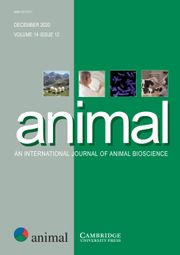Article contents
Effect of pre-slaughter handling, exercise and the presence of a dog on lamb welfare and meat quality
Published online by Cambridge University Press: 26 February 2016
Abstract
Before slaughter, lambs may experience several stressors such as feed and water deprivation, handling and transport that have the potential to negatively impact welfare and meat quality. The objective of this study was to evaluate the effect of pre-slaughter handling, exercise and the presence of a dog on the behaviour and physiology of lambs and meat quality at slaughter. At 6 months of age, 60 lambs (n=20 lambs/replicate; three replicates) were allocated to one of the two treatment groups (n=30 lambs/treatment): low (LOW) intensive handling or high (HIGH) intensive handling. LOW lambs were moved short distances, quietly and without the use of a dog before transport. HIGH lambs were moved quickly, long distances and with a dog present before transport. Lamb behaviour (standing, lying, rumination and panting) was recorded for 1 h before (post-treatment) and after transport (post-transport), and for 30 min before slaughter (pre-slaughter). Blood samples were collected before (baseline), after transport (post-transport) and at exsanguination (at slaughter) to assess cortisol, lactate and non-esterified fatty acid (NEFA) concentrations. At slaughter, lamb carcases (M. longissimus lumborum) were evaluated for pH levels, drip and cook loss, and tenderness. HIGH lambs spent more time standing (P<0.001) and panting (P<0.001) and less time lying (P<0.001) and ruminating (P<0.001) post-treatment than LOW lambs, but more (P<0.001) time ruminating post-transport. All lambs spent more time standing (P<0.001) and less time lying (P<0.001) and panting (P<0.001) post-transport and pre-slaughter than post-treatment. Cortisol concentrations were greater (P<0.001) in lambs post-transport and at slaughter compared with baseline values. Lactate concentrations were lower (P=0.002) in HIGH than LOW lambs. In addition, NEFA concentrations were higher (P<0.001) post-transport and at slaughter in HIGH compared with LOW lambs. Ultimate pH was higher (P<0.001) in HIGH than LOW lambs and pH declined quicker (P=0.012) in LOW than HIGH lambs. Cook loss, drip loss and shear force were lower (P⩽0.05) in HIGH than LOW lambs. The HIGH intensive pre-slaughter handling regime used in the present study caused stress in lambs and increased ultimate pH that could potentially negatively impact welfare, product quality and consistency.
Information
- Type
- Research Article
- Information
- Copyright
- © The Animal Consortium 2016
References
- 7
- Cited by

